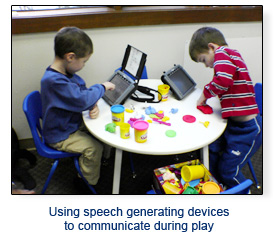Wow what a journey this has been! Thinking back to the beginning
of this blog and class I have realized how much I have learned throughout this journey.
Previous to this course I had no idea what assistive
technology entailed. From way back in August we learned about UDL and the principles to design great
instruction for our students and how make a plan for all learners through PAL. I learned and discussed how to
better reflect on lessons to see if UDL was incorporated in the best ways and
what curriculum barriers I am
creating in my own instruction. It involves steps I now repeat to myself when
planning, which are representation,
action, expression and engagement. Looking back I realize why we started
with UDL and that is because it is truly the beginning to set the stage for
success and the beginning of integrating technology.
 We then moved into my favorite topic we’ve discussed, which
is communication and specific devices for each student. I learned so
much! I learned about AT devices I never knew existed and about computer
features that are at our fingertips that I never knew about. These computer
features I have incorporated for some of my own students, like text magnification and slowing down the
cursor and pace, and mouse alternatives.
I didn’t know what adapted keyboards
meant and that multisensory software
exists. I learned about the wealth of
applications available for IPads. I was able to dive deeper into learning
about voice output communication devices,
like the BigMack. It can be used for so many more uses than I ever imagined.
We then moved into my favorite topic we’ve discussed, which
is communication and specific devices for each student. I learned so
much! I learned about AT devices I never knew existed and about computer
features that are at our fingertips that I never knew about. These computer
features I have incorporated for some of my own students, like text magnification and slowing down the
cursor and pace, and mouse alternatives.
I didn’t know what adapted keyboards
meant and that multisensory software
exists. I learned about the wealth of
applications available for IPads. I was able to dive deeper into learning
about voice output communication devices,
like the BigMack. It can be used for so many more uses than I ever imagined.
I learned that devices
can be categorized in low, mid, or high tech. I learned the process of assessment for devices and
steps to take to determine the appropriate type of assistive technology for a
student. I learned that SETT is there
to help with that entire process. I never knew what Augmentative and Alternative Communication was and the term frightened
me a bit at first! Now I know this includes all forms of communication (other
than oral speech) that are used to express thoughts, needs, wants, and ideas.
We all use AAC when we make facial
expressions or gestures, use symbols or pictures, or write. Special augmentative aids, such as picture and symbol communication boards
and electronic devices, are available to help people express themselves.
I was able to dive deeper into the IEP process and it became
less intimidating as we went on, because of the resources we were able to
locate and try out on our own. We then dove into AT in reading and math, which provided me with endless resources to
help my tier 3 students and well as tier 1 students. I also feel better
equipped to enter a special needs classroom with the knowledge that I have on
devices and software available to create accessibility
for all learners!
I realized my earlier posts were more information and fact
based and providing information and places to find help and guides. As my posts
progressed, I was able to better apply what I was learning to my own classroom and
current student needs like I mentioned above. I can’t wait to try out the virtual
manipulatives with my students. They will absolutely love them, and their
success with concepts will soar.
Overall, I loved blogging with all of you and being able to
share in our findings and learn from one another. The IEP process no longer
seems daunting when you take considerations
into mind, along with the steps to trial and error. It’s all about involving
all staff and the family to choose the best device! I am familiar with the
types of devices available to one day be able to help suggest an appropriate
one. Most importantly, I am to take away UDL
guidelines that have been improving my classroom instruction and a variety
of resources and websites to bring into my instruction as well. I am thankful
to have had such engaging and thought provoking classmates to make this journey
even more worthwhile!
Hope you have enjoyed my thoughts, advice, and resources to
take with you!
~ Michelle

~ Michelle





